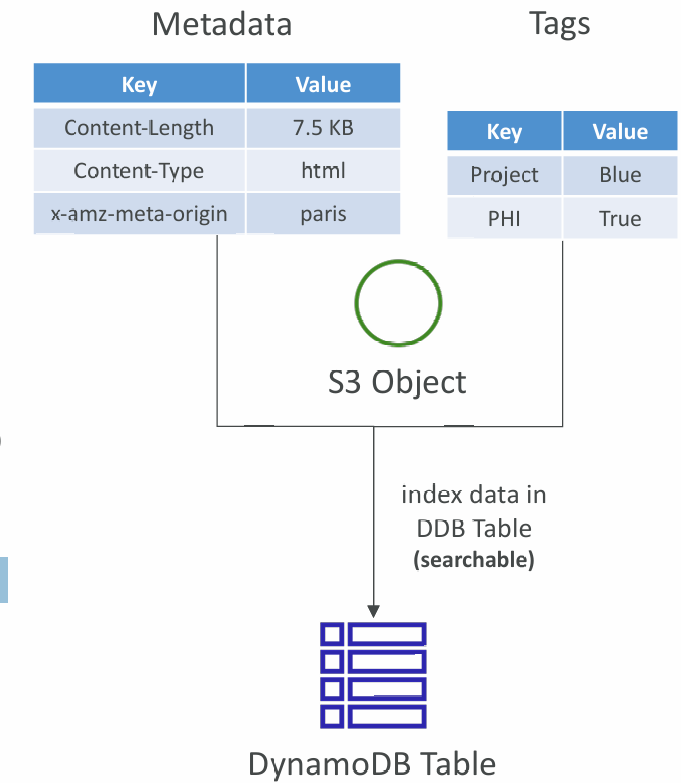S3
- Amazon S3 is one of the main building blocks of AWS
- It’s advertised as ”infinitely scaling” storage
- Many websites use Amazon S3 as a backbone
- Many AWS services use Amazon S3 as an integration as well
Use cases
- Backup and storage
- Disaster Recovery
- Archive
- Hybrid Cloud storage
- Application hosting
- Media hosting
- Data lakes & big data analytics
- Software delivery
- Static website
Buckets
- Amazon S3 allows people to store objects (files) in “buckets” (directories)
- Buckets must have a globally unique name (across all regions all accounts)
- Buckets are defined at the region level
- S3 looks like a global service but buckets are created in a region
- Naming convention
- No uppercase, No underscore
- 3-63 characters long
- Not an IP
- Must start with lowercase letter or number
- Must NOT start with the prefix xn-
- Must NOT end with the suffix -s3alias
Objects
- Objects (files) have a Key
- The key is the FULL path:
- s3://my-bucket/my_file.txt
- s3://my-bucket/my_folder1/another_folder/my_file.txt
- The key is composed of prefix + object name
- s3://my-bucket/my_folder1/another_folder/my_file.txt
- There’s no concept of “directories” within buckets (although the UI will trick you to think otherwise)
- Just keys with very long names that contain slashes (“/”)
- Object values are the content of the body:
- Max. Object Size is 5TB (5000GB)
- If uploading more than 5GB, must use “multi-part upload”
- Metadata (list of text key / value pairs – system or user metadata)
- Tags (Unicode key / value pair – up to 10) – useful for security / lifecycle
- Version ID (if versioning is enabled)
Amazon S3 – Security
- User-Based
- IAM Policies – which API calls should be allowed for a specific user from IAM
- Resource-Based
- Bucket Policies – bucket wide rules from the S3 console - allows cross account
- Object Access Control List (ACL) – finer grain (can be disabled)
- Bucket Access Control List (ACL) – less common (can be disabled)
- Note: an IAM principal can access an S3 object if
- The user IAM permissions ALLOW it OR
- AND there’s no explicit DENY
- Encryption: encrypt objects in Amazon S3 using encryption keys
Bucket Policies
- JSON based policies
- Resources: buckets and objects
- Effect: Allow / Deny
- Actions: Set of API to Allow or Deny
- Principal: The account or user to apply the policy to
- Use S3 bucket for policy to:
- Grant public access to the bucket
- Force objects to be encrypted at upload
- Grant access to another account (Cross Account)
Bucket settings for Block Public Access
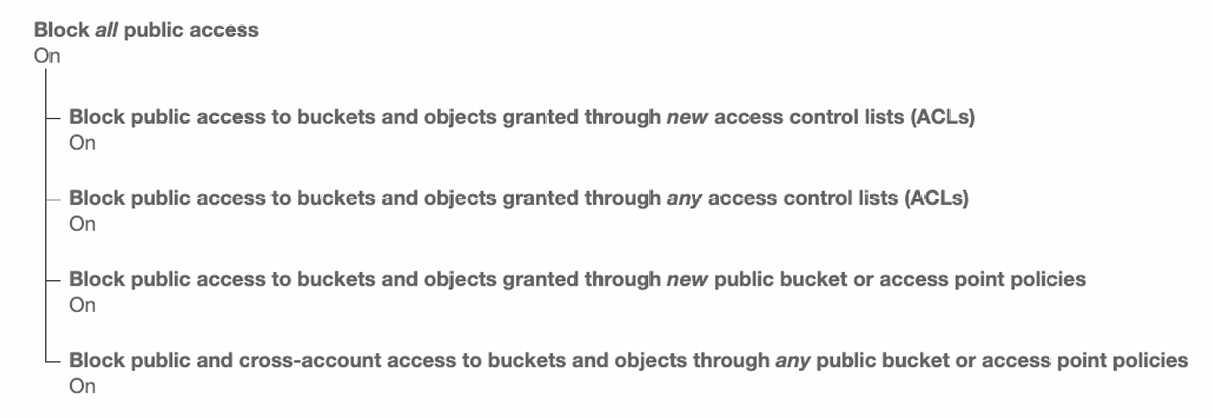
- These settings were created to prevent company data leaks
- If you know your bucket should never be public, leave these on
- Can be set at the account level
Object Encryption
- You can encrypt objects in S3 buckets using one of 4 methods
- Server-Side Encryption (SSE)
- Server-Side Encryption with Amazon S3-Managed Keys (SSE-S3) - Enabled by default
- Encrypts S3 objects using keys handled, managed, and owned by AWS
- Server-Side Encryption with KMS Keys stored in AWS KMS (SSE-KMS)
- Leverage AWS Key Management Service (AWS KMS) to manage encryption keys
- Server-Side Encryption with Customer-Provided Keys (SSE-C)
- When you want to manage your own encryption keys
- Server-Side Encryption with Amazon S3-Managed Keys (SSE-S3) - Enabled by default
- Client-Side Encryption
It’s important to understand which ones are for which situation for the exam.
S3 Encryption – SSE-S3
- Encryption using keys handled, managed, and owned by AWS
- Object is encrypted server-side
- Encryption type is AES-256
- Must set header "x-amz-server-side-encryption": "AES256"
- Enabled by default for new buckets & new objects
S3 Encryption – SSE-KMS
- Encryption using keys handled and managed by AWS KMS (Key Management Service)
- KMS advantages: user control + audit key usage using CloudTrail
- Object is encrypted server side
- Must set header "x-amz-server-side-encryption": "aws:kms"
SSE-KMS Limitation
- If you use SSE-KMS, you may be impacted by the KMS limits
- When you upload, it calls the GenerateDataKey KMS API
- When you download, it calls the Decrypt KMS API
- Count towards the KMS quota per second (5500, 10000, 30000 req/s based on region)
- You can request a quota increase using the Service Quotas Console
S3 Encryption – SSE-C
- Server-Side Encryption using keys fully managed by the customer outside of AWS
- Amazon S3 does NOT store the encryption key you provide
- HTTPS must be used
- Encryption key must provided in HTTP headers, for every HTTP request made
S3 Encryption – Client-Side Encryption
- Use client libraries such as Amazon S3 Client-Side Encryption Library
- Clients must encrypt data themselves before sending to Amazon S3
- Clients must decrypt data themselves when retrieving from Amazon S3
- Customer fully manages the keys and encryption cycle
S3 – Encryption in transit (SSL/TLS)
- Encryption in flight is also called SSL/TLS
- Amazon S3 exposes two endpoints:
- HTTP Endpoint – non encrypted
- HTTPS Endpoint – encryption in flight
- HTTPS is recommended
- HTTPS is mandatory for SSE-C
- Most clients would use the HTTPS endpoint by default
Force Encryption in Transit
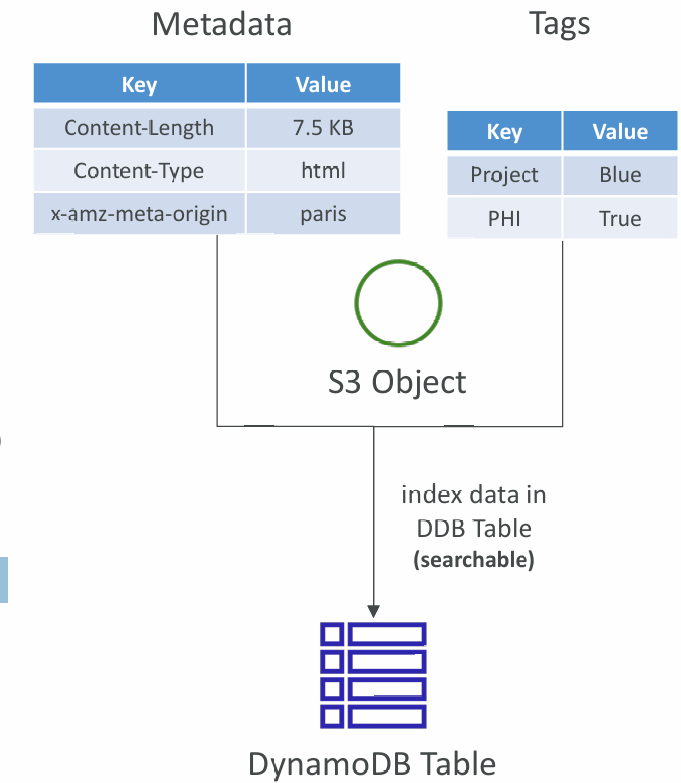
Default Encryption vs. Bucket Policies
- SSE-S3 encryption is automatically applied to new objects stored in S3 bucket
- Optionally, you can “force encryption” using a bucket policy and refuse any API call to PUT an S3 object without encryption headers (SSE-KMS or SSE-C)

Note: Bucket Policies are evaluated before “Default Encryption”
CORS
- Origin = scheme (protocol) + host (domain) + port
- Web Browser based mechanism to allow requests to other origins while visiting the main origin
- Same origin: http://example.com/app1 & http://example.com/app2
- Different origins: http://www.example.com & http://other.example.com
- The requests won’t be fulfilled unless the other origin allows for the requests, using CORS Headers (example: Access-Control-Allow-Origin)
- If a client makes a cross-origin request on our S3 bucket, we need to enable the correct CORS headers
- It’s a popular exam question
- You can allow for a specific origin or for * (all origins)

MFA Delete
- MFA (Multi-Factor Authentication) – force users to generate a code on a device (usually a mobile phone or hardware) before doing important operations on S3
- MFA will be required to:
- Permanently delete an object version
- Suspend Versioning on the bucket
- MFA won’t be required to:
- Enable Versioning
- List deleted versions
- To use MFA Delete, Versioning must be enabled on the bucket
- Only the bucket owner (root account) can enable/disable MFA Delete
Access Logs
- For audit purpose, you may want to log all access to S3 buckets
- Any request made to S3, from any account, authorized or denied, will be logged into another S3 bucket
- That data can be analyzed using data analysis tools…
- The target logging bucket must be in the same AWS region
- Do not set your logging bucket to be the monitored bucket
- It will create a logging loop, and your bucket will grow exponentially
Pre-Signed URLs
- Generate pre-signed URLs using the S3 Console, AWS CLI or SDK
- URL Expiration
- S3 Console – 1 min up to 720 mins (12 hours)
- AWS CLI – configure expiration with --expires-in parameter in seconds (default 3600 secs, max. 604800 secs ~ 168 hours)
- Users given a pre-signed URL inherit the permissions of the user that generated the URL for GET / PUT
Examples:
- Allow only logged-in users to download a premium video from your S3 bucket
- Allow an ever-changing list of users to download files by generating URLs dynamically
- Allow temporarily a user to upload a file to a precise location in your S3 bucket
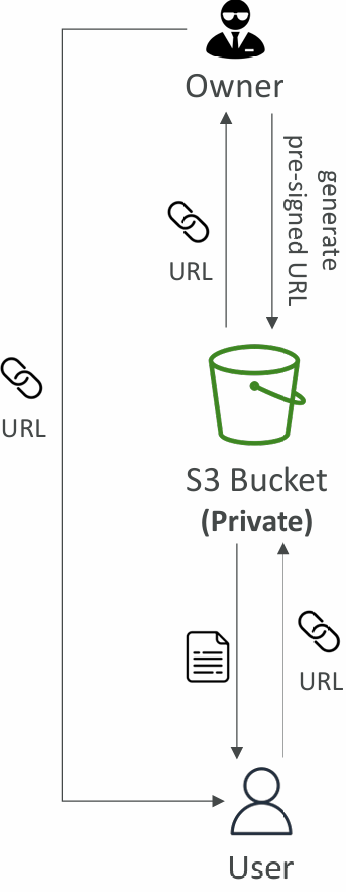
Access Points
- Access Points simplify security management for S3 Buckets
- Each Access Point has:
- its own DNS name (Internet Origin or VPC Origin)
- an access point policy (similar to bucket policy) – manage security at scale

VPC Origin
- We can define the access point to be accessible only from within the VPC
- You must create a VPC Endpoint to access the Access Point (Gateway or Interface Endpoint)
- The VPC Endpoint Policy must allow access to the target bucket and Access Point
S3 Object Lambda
- Use AWS Lambda Functions to change the object before it is retrieved by the caller application
- Only one S3 bucket is needed, on top of which we create S3 Access Point and S3 Object Lambda Access Points
- Use Cases:
- Redacting personally identifiable information for analytics or non-production environments
- Converting across data formats, such as converting XML to JSON
- Resizing and watermarking images on the fly using caller-specific details, such as the user who requested the object
Static Website Hosting
- S3 can host static websites and have them accessible on the Internet
- The website URL will be (depending on the region)
- If you get a 403 Forbidden error, make sure the bucket policy allows public reads!
Versioning
- You can version your files in Amazon S3
- It is enabled at the bucket level
- Same key overwrite will change the “version”: 1, 2, 3….
- It is best practice to version your buckets
- Protect against unintended deletes (ability to restore a version)
- Easy roll back to previous version
- Notes:
- Any file that is not versioned prior to enabling versioning will have version “null”
- Suspending versioning does not delete the previous versions
Replication (CRR & SRR)
- Must enable Versioning in source and destination buckets
- Cross-Region Replication (CRR)
- Same-Region Replication (SRR)
- Buckets can be in different AWS accounts
- Copying is asynchronous
- Must give proper IAM permissions to S3
Use cases:
- CRR – compliance, lower latency access, replication across accounts
- SRR – log aggregation, live replication between production and test accounts
Details
- After you enable Replication, only new objects are replicated
- Optionally, you can replicate existing objects using S3 Batch Replication
- Replicates existing objects and objects that failed replication
- For DELETE operations
- Can replicate delete markers from source to target (optional setting)
- Deletions with a version ID are not replicated (to avoid malicious deletes)
- There is no “chaining” of replication
- If bucket 1 has replication into bucket 2, which has replication into bucket 3
- Then objects created in bucket 1 are not replicated to bucket 3
Storage Classes
- Amazon S3 Standard - General Purpose
- Amazon S3 Standard-Infrequent Access (IA)
- Amazon S3 One Zone-Infrequent Access
- Amazon S3 Glacier Instant Retrieval
- Amazon S3 Glacier Flexible Retrieval
- Amazon S3 Glacier Deep Archive
- Amazon S3 Intelligent Tiering
Can move between classes manually or using S3 Lifecycle configurations
Durability and Availability
- Durability
- High durability (99.999999999%) of objects across multiple AZ
- If you store 10,000,000 objects with Amazon S3, you can on average expect to incur a loss of a single object once every 10,000 years
- Same for all storage classes
- Availability
- Measures how readily available a service is
- Varies depending on storage class
- Example: S3 standard has 99.99% availability = not available 53 minutes a year
S3 Standard – General Purpose
- 99.99% Availability
- Used for frequently accessed data
- Low latency and high throughput
- Sustain 2 concurrent facility failures
- Use Cases: Big Data analytics, mobile & gaming applications, content distribution…
S3 Storage Classes – Infrequent Access
- For data that is less frequently accessed, but requires rapid access when needed
- Lower cost than S3 Standard
- Amazon S3 Standard-Infrequent Access (S3 Standard-IA)
- 99.9% Availability
- Use cases: Disaster Recovery, backups
- Amazon S3 One Zone-Infrequent Access (S3 One Zone-IA)
- High durability (99.999999999%) in a single AZ; data lost when AZ is destroyed
- 99.5% Availability
- Use Cases: Storing secondary backup copies of on-premises data, or data you can recreate
S3 Glacier Storage Classes
- Low-cost object storage meant for archiving / backup
- Pricing: price for storage + object retrieval cost
Amazon S3 Glacier Instant Retrieval
- Millisecond retrieval, great for data accessed once a quarter
- Minimum storage duration of 90 days
Amazon S3 Glacier Flexible Retrieval
- Expedited (1 to 5 minutes), Standard (3 to 5 hours), Bulk (5 to 12 hours) – free
- Minimum storage duration of 90 days
Amazon S3 Glacier Deep Archive
- Standard (12 hours), Bulk (48 hours)
- Minimum storage duration of 180 days
S3 Intelligent-Tiering
- Small monthly monitoring and auto-tiering fee
- Moves objects automatically between Access Tiers based on usage
- There are no retrieval charges in S3 Intelligent-Tiering
Tiers:
- Frequent Access tier (automatic): default tier
- Infrequent Access tier (automatic): objects not accessed for 30 days
- Archive Instant Access tier (automatic): objects not accessed for 90 days
- Archive Access tier (optional): configurable from 90 days to 700+ days
- Deep Archive Access tier (optional): config. from 180 days to 700+ days
Storage Classes Comparison
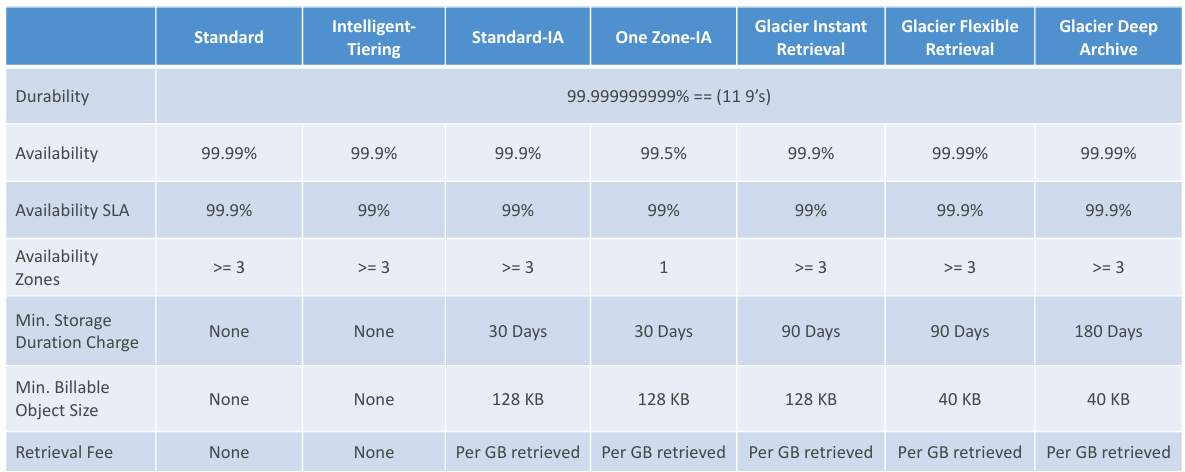
Moving between Storage Classes
- You can transition objects between storage classes
- For infrequently accessed object, move them to Standard IA
- For archive objects that you don’t need fast access to, move them to Glacier or Glacier Deep Archive
- Moving objects can be automated using a Lifecycle Rules
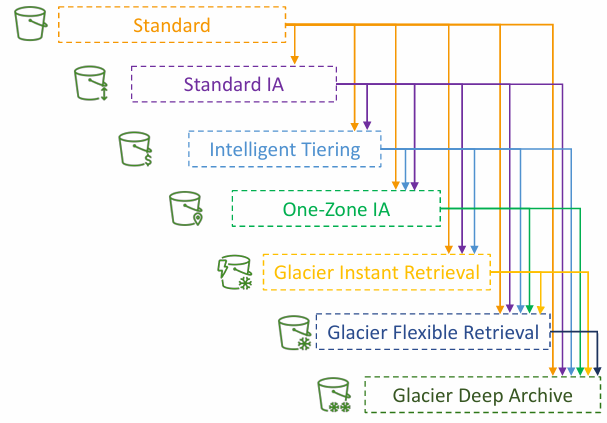
Lifecycle Rules
- Transition Actions – configure objects to transition to another storage class
- Move objects to Standard IA class 60 days after creation
- Move to Glacier for archiving after 6 months
- Expiration actions – configure objects to expire (delete) after some time
- Access log files can be set to delete after a 365 days
- Can be used to delete old versions of files (if versioning is enabled)
- Can be used to delete incomplete Multi-Part uploads
- Rules can be created for a certain prefix (example: s3://mybucket/mp3/*)
- Rules can be created for certain objects Tags (example: Department: Finance)
Lifecycle Rules (Scenario 1)
Your application on EC2 creates images thumbnails after profile photos are uploaded to Amazon S3. These thumbnails can be easily recreated, and only need to be kept for 60 days. The source images should be able to be immediately retrieved for these 60 days, and afterwards, the user can wait up to 6 hours. How would you design this?
- S3 source images can be on Standard, with a lifecycle configuration to transition them to Glacier after 60 days
- S3 thumbnails can be on One-Zone IA, with a lifecycle configuration to expire them (delete them) after 60 days
Amazon S3 – Lifecycle Rules (Scenario 2)
A rule in your company states that you should be able to recover your deleted S3 objects immediately for 30 days, although this may happen rarely. After this time, and for up to 365 days, deleted objects should be recoverable within 48 hours.
- Enable S3 Versioning in order to have object versions, so that “deleted objects” are in fact hidden by a “delete marker” and can be recovered
- Transition the “noncurrent versions” of the object to Standard IA
- Transition afterwards the “noncurrent versions” to Glacier Deep Archive
S3 Analytics – Storage Class Analysis
- Help you decide when to transition objects to the right storage class
- Recommendations for Standard and Standard IA
- Does NOT work for One-Zone IA or Glacier
- Report is updated daily
- 24 to 48 hours to start seeing data analysis
- Good first step to put together Lifecycle Rules (or improve them)!
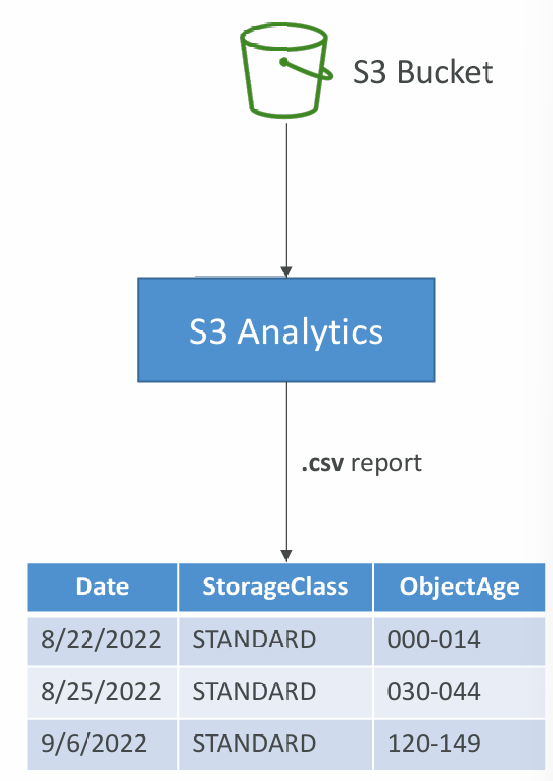
S3 Event Notifications
- S3:ObjectCreated, S3:ObjectRemoved, S3:ObjectRestore, S3:Replication…
- Object name filtering possible (*.jpg)
- Use case: generate thumbnails of images uploaded to S3
- Can create as many “S3 events” as desired
- S3 event notifications typically deliver events in seconds but can sometimes take a minute or longer
Event Notifications – IAM Permissions
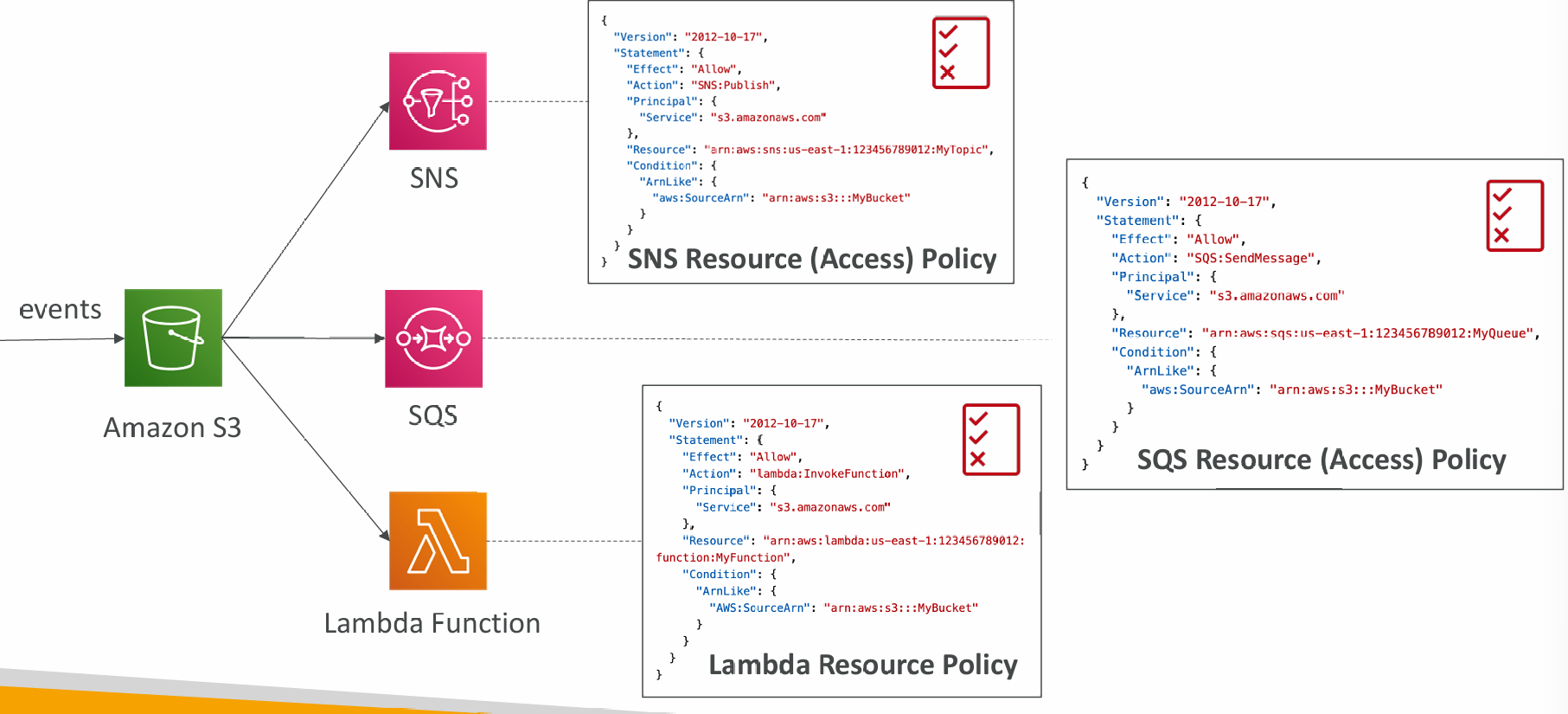
Event Notifications with Amazon EventBridge

- Advanced filtering options with JSON rules (metadata, object size, name...)
- Multiple Destinations – ex Step Functions, Kinesis Streams / Firehose…
- EventBridge Capabilities – Archive, Replay Events, Reliable delivery
S3 Baseline Performance
- Amazon S3 automatically scales to high request rates, latency 100-200 ms
- Your application can achieve at least 3,500 PUT/COPY/POST/DELETE or 5,500 GET/HEAD requests per second per prefix in a bucket
- There are no limits to the number of prefixes in a bucket
- Example (object path => prefix):
- bucket/folder1/sub1/file => /folder1/sub1/
- bucket/folder1/sub2/file => /folder1/sub2/
- bucket/1/file => /1/
- bucket/2/file => /2/
- If you spread reads across all four prefixes evenly, you can achieve 22,000 requests per second for GET and HEAD
Multi-Part upload
- recommended for files > 100MB, must use for files > 5GB
- Can help parallelize uploads (speed up transfers)
S3 Transfer Acceleration
- Increase transfer speed by transferring file to an AWS edge location which will forward the data to the S3 bucket in he target region
- Compatible with multi-part upload
S3 Byte-Range Fetches
- Parallelize GETs by requesting specific byte ranges
- Better resilience in case of failures

S3 User-Defined Object Metadata & S3 Object Tags
S3 User-Defined Object Metadata
- When uploading an object, you can also assign metadata
- Name-value (key-value) pairs
- User-defined metadata names must begin with "x-amz-meta-”
- Amazon S3 stores user-defined metadata keys in lowercase
- Metadata can be retrieved while retrieving the object
S3 Object Tags
- Key-value pairs for objects in Amazon S3
- Useful for fine-grained permissions (only access specific objects with specific tags)
- Useful for analytics purposes (using S3 Analytics to group by tags)
- You cannot search the object metadata or object tags
- Instead, you must use an external DB as a search index such as DynamoDB
